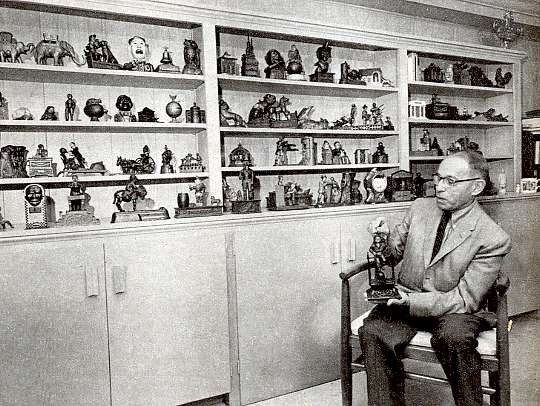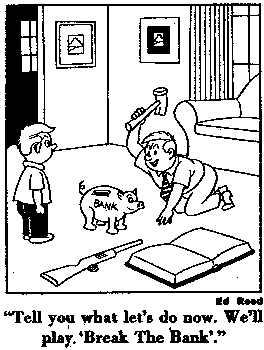LOUISVILLE (Kentucky) COURIER — SUNDAY MAGAZINE — September 2, 1962
You
Can Bank On A Hobby
By: Jane Hunt Clark

Louis Rosenberg sits in the family room of his
Lexington home, a whole wall of
which is devoted to his mechanical-bank collection, one of the nation's finest.
Put a coin in the slot of any mechanical bank a
Lexington man owns — and the action starts!
"YOUNG
man, get a hobby; preferably get two." Such was the advice of Edward
Newton in the 19th Century. And his suggestion was good enough for Louis
Rosenberg of Lexington.
Rosenberg has many hobbies. His favorite is his large
collection of mechanical banks, which is rated as the second largest in the
country .
The Rosenberg collection is displayed on
specially-built wooden shelves which cover one wall of the family room at
Rosenberg's home. And each bank works. You put a coin in the slot and a
cast-iron man (or maybe a dog) goes into action, usually something funny.
Most of the mechanical banks betray their age by their
much-used appearances. Bits of paint are gone here and there, which is the
condition that is desired by bank collectors. If they
look too perfect, if their brightly colored paint is in excellent condition, the
bank is suspected of being a reproduction and is not sought after as a
collector's item.
About 250 major types of mechanical banks have been
manufactured. The first one dates back to 1870. Others were made until the late
1920's, with the greatest variety of banks being manufactured from about 1870
until 1910. Out of the 250 varieties, Rosenberg has 120 models.
The old iron toys have become of great interest to
collectors in recent years. As time goes on, they become more scarce and thus
more valuable. Originally designed to teach children thrift by amusing them as
they saved their pennies, most of the old banks have a certain slapstick humor
in their action. The depositing of a penny is accompanied or followed by some
sort of unexpected motion.
Strangely enough, the oldest banks had the least
action. But as more and more banks came into being, the actions became more
complicated.
 Most old banks sold for very little originally .Some of
the rarest once sold for 10 or 15 cents each. These same banks are bringing high
prices on today's market. The Merry-Go-Round Bank, for instance, once sold for
$8.50 a dozen. The asking price is now $8,000—for one.
Most old banks sold for very little originally .Some of
the rarest once sold for 10 or 15 cents each. These same banks are bringing high
prices on today's market. The Merry-Go-Round Bank, for instance, once sold for
$8.50 a dozen. The asking price is now $8,000—for one.
Rosenberg's hobby started in 1943 when he sold his
jewelry stores and found himself with time on his hands. A friend suggested
collecting mechanical banks, and Rosenberg began looking around for them. Now,
almost 19 years later, he is still at it, more interested than ever.
NOTHING
is too much trouble for him if an old bank is involved. Rosenberg will fly
almost anywhere to buy another. He locates banks through antique and hobby
magazines, trips to antique shows, and through phone calls from friends who
stumble on the trail of a wanted bank.
Finding a
bank at a bargain price is a rare occasion. Only once has Rosenberg found a
prize at an unbelievably low price. He got his Presto Bank in a secondhand store
for 50 cents. It is now worth about $150.
Rosenberg has paid up to $600 for his banks, and many
are worth much more. His Boy Scout Bank alone is worth $1,000.
The Tabby Bank, manufactured about 1880, is the oldest
bank in the Rosenberg collection. It originally sold for 19 cents and today
would be a bargain at $250. A favorite? Rosenberg is especially partial to his
rarest bank, The Pegleg Beggar.
It has a small, seated pegleg beggar with his hat in
his hand. When a penny is deposited in the slot, the beggar drops his hat to the
ground and nods his head in gratitude. Since the beggar is a rather colorless
figure, the bank was not made in abundance. Hence, the bank is rare and
Rosenberg wouldn't take $1,200 for it.
Other
favorites include The Trick Dog, which takes a penny in his mouth, jumps through
a hoop and drops the coin into a barrel. The Trick Dog is a very colorful bank
and has lots of action.
The Darktown Battery , another Rosenberg favorite,
depicts a group of Negro boys of 1880 playing baseball. A coin is placed in the
hand of the pitcher who then throws the penny or "baseball." The
batter strikes and misses. The penny goes over the plate, falls into an opening
in front of the catcher and goes down into the bank.
Obviously, Rosenberg keeps a large supply of pennies on
hand. But a few mechanical banks were made to hold paper money. One of this
type, the Dog House Bank is in the Rosenberg collection.
Many banks with hardly any mechanical action are of
great value. Such is the case with Rosenberg's 50-cent bargain, the Presto Bank.
A bank building is shown and when a penny is dropped into the slot, a tiny
drawer pops out. This is the only action the bank has, yet it is truly a
collector's item, and almost impossible to find.
Most mechanical banks have their names in their iron
bases, and for that reason they can be easily and accurately identified,
regardless of age or condition.
Among the wide range of banks in the Rosenberg collection are:
Hall's Excelsior Bank: This is the first patented mechanical bank in
existence, although it has very little action. A monkey cashier sitting on top
of the bank takes the coin, bows, and disappears into the, top of the bank.
Independence Hall: This bank, shaped like Independence Hall, is only
semi-mechanical. When the coin is inserted, a lever rings a bell.
Bucking Buffalo: When a coin is placed in the slot, a buffalo butts a
small boy and sends him up a tree stump. A bear cub sits on top of the stump
watching the proceedings. He just sits and does nothing.
 Others include:
Others include:
Uncle Sam: A penny is placed in Uncle Sam's hand, a "carpet
bag" labeled "U. S." opens, and the coin drops into the bag and
ends up in the Treasury Department below.
Eagles and Eaglettes: A mother eagle sits before her brood of baby
eagles. When a coin is deposited in her mouth, she feeds the babies whose mouths
open as hers does.
Another of Rosenberg's favorites is the Organ Grinder Bank. An organ
grinder and his monkey are shown. A penny placed in the monkey's mouth is
deposited by the monkey into the organ grinder's box. And there's the one that
shows William Tell shooting an apple off a boy's head.
Let's not overlook Jonah. He apparently is about
to be thrown into the whale's mouth from the small boat. Instead, however, the
coin, which is placed on a tray in Jonah's hands, is tossed into the whale's
mouth which opens just in time to receive it.
Among the other mechanical banks are several with such choice names as (and
the action usually is choice, too):
Santa Claus (naturally, he couldn't be overlooked), The Trick Pony,
Lion and Monkeys, Reclining Chinaman, World's Fair Bank, Pump
and Bucket Bank, Boy on Trapeze, Paddy and The Pig, Tammany
Banker and Dog Charges Boy.
And so it goes. Yes, sir, Rosenberg has quite a need for pennies—and not for
parking meters or the sales tax.
Jane's At The Typewriter Again
You know by this time, if you started at the
beginning of this story, that Miss Jane Hunt Clark of Lexington is back with us
again. Remember her? She's the author of our recent piece about contending with
salesmen who beat a path to the door. We expect to receive other pieces from her
as time goes by, and they'll be welcome.
